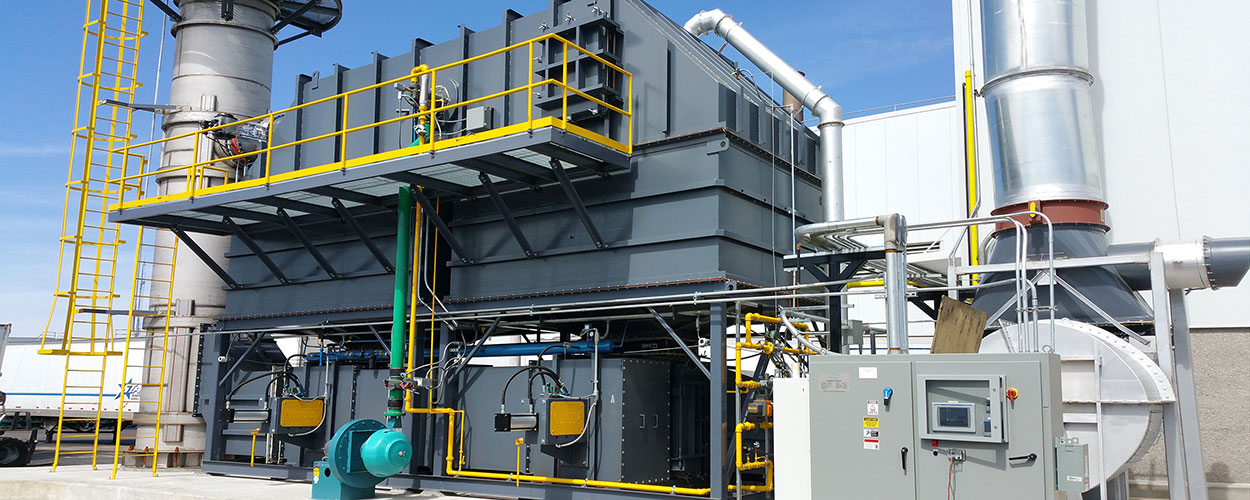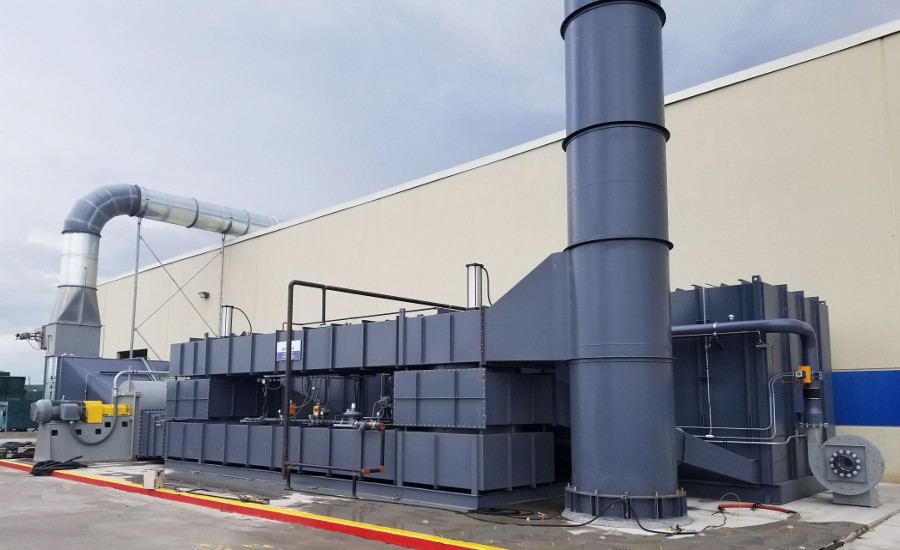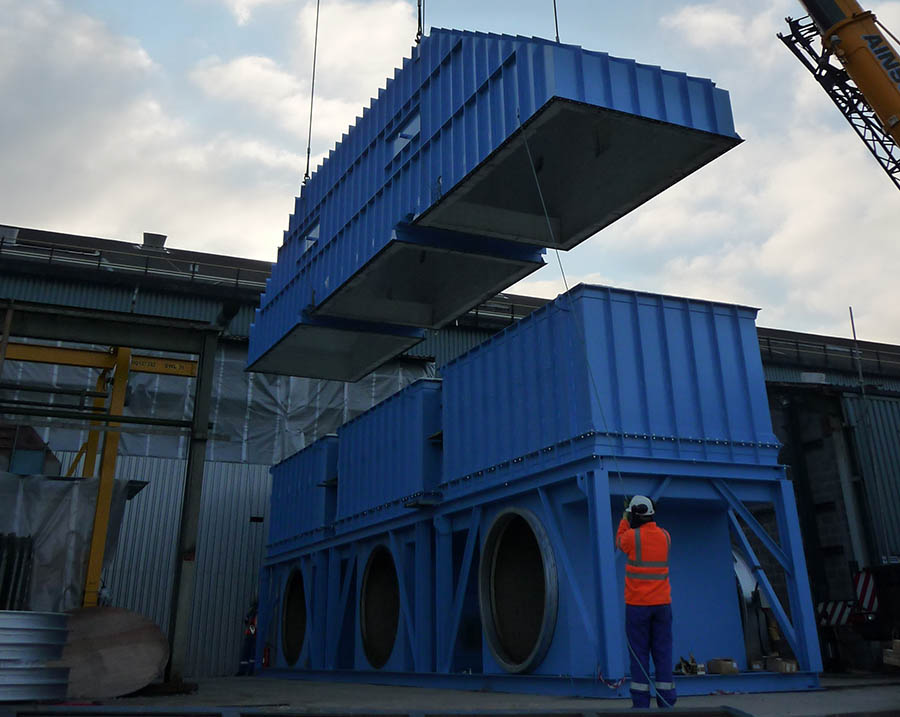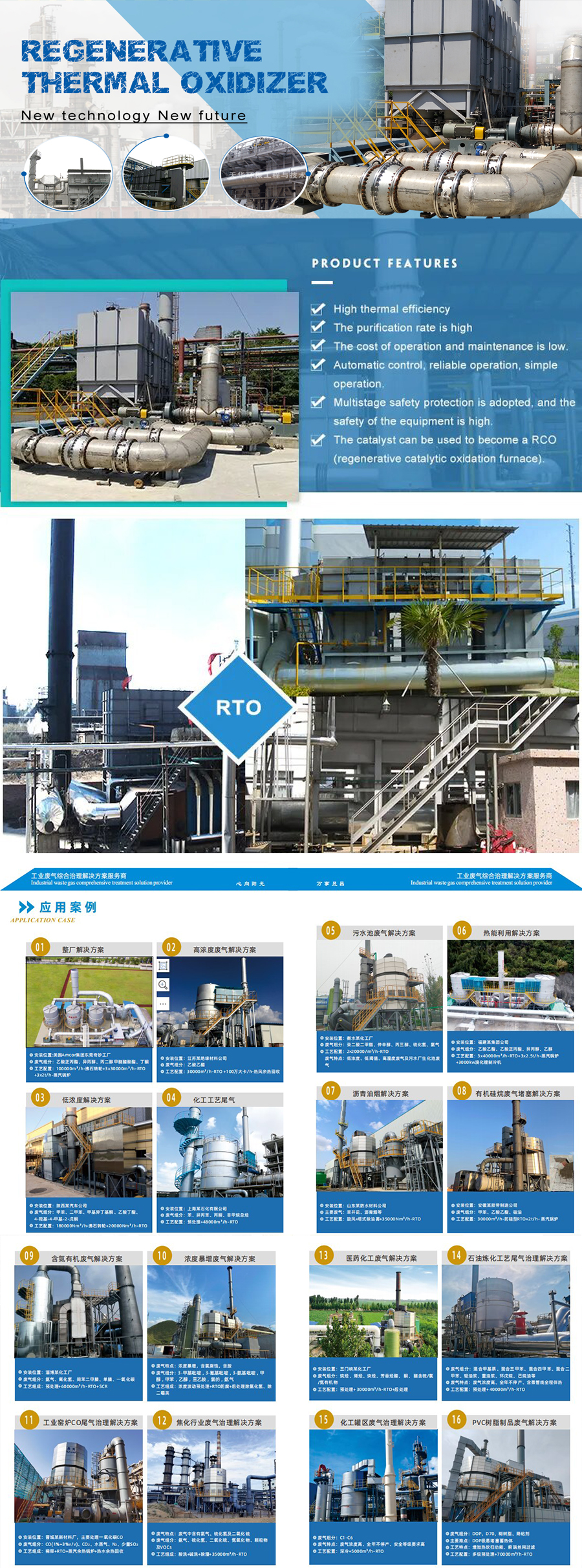Maklumat Asas.
Model NO.
RTO yang menakjubkan
taip
Insinerator
Penyelenggaraan Rendah
100
Operasi Mudah
100
Penjimatan Tenaga
100
Kecekapan Tinggi
100
Tanda dagangan
Bjamazing
Pakej Pengangkutan
Luar negara
Spesifikasi
111
asal usul
China
Kod HS
2221111
Penerangan Produk
RTO
Pengoksida Terma Penjanaan Semula
Compared with traditional catalytic combustion, direct thermal oxidizer, RTO has the merits of high heating efficiency, low operation cost, and the ability to treat large flux low concentration waste gas. When VOCs concentration is high, secondary heat recycle can be realized, which will greatly reduce the operation cost. Because RTO can preheat the waste gas by levels through ceramic heat accumulator, which could make the waste gas to be completely heated and cracked with no dead corner(treatment efficiency>99%),which reduce the NOX in the Exhausting gas, if the VOC density >1500mg/Nm3, when the waste gas reach cracking area, it has been heated up to cracking temperature by heat accumulator, the burner will be closed under this condition.
RTO can be devided into chamber type and rotary type according to difference operation mode. Rotary type RTO has advantages in system pressure, temperature stability, investment amount, etc
| jenis RTO | Kecekapan | Perubahan tekanan (mmAq) | Saiz | (max)Treatment volume | |
| Kecekapan rawatan | Kecekapan kitar semula haba | ||||
| RTO jenis putar | 99 % | 97 % | 0-4 | kecil (1 time) | 50000Nm3/h |
| RTO jenis tiga ruang | 99 % | 97 % | 0-10 | besar (1.5times) | 100000Nm3/h |
| RTO jenis dua ruang | 95 % | 95 % | 0-20 | tengah (1.2times) | 100000Nm3/h |
Regenerative Thermal Oxidizer, Regenerative Thermal Oxidizer, Regenerative Thermal Oxidizer, Thermal Oxidizer, Thermal Oxidizer, Thermal Oxidizer, oxidizer, oxidizer, oxidizer, incinerator, incinerator, incinerator, waste gas treatment, waste gas treatment, waste gas treatment, VOC treatment, VOC treatment, VOC treatment, RTO, RTO, RTO, Rotary RTO, Rotary RTO, Rotary RTO, Chamber RTO, Chamber RTO, Chamber RTO
Alamat: tingkat 8, E1, bangunan Pinwei, jalan Dishengxi, Yizhuang, ZheJiang, China
Jenis Perniagaan: Pengeluar/Kilang, Syarikat Perdagangan
Julat Perniagaan: Elektrik & Elektronik, Peralatan & Komponen Industri, Jentera Pembuatan & Pemprosesan, Metalurgi, Mineral & Tenaga
Pensijilan Sistem Pengurusan: ISO 9001, ISO 14001
Produk Utama: Rto, Talian Salutan Warna, Talian Galvanisasi, Pisau Udara, Alat Ganti untuk Talian Pemprosesan, Coater, Peralatan Bebas, Gulung Sink, Projek Ubahsuai, Blower
Pengenalan Syarikat: ZheJiang Amazing Science & Technology Co., Ltd ialah sebuah syarikat berteknologi tinggi yang berkembang maju, terletak di ZheJiang Economic and Technological Development Area(BDA). Berpegang kepada konsep Realistik, Inovatif, Fokus dan Cekap, syarikat kami menyediakan perkhidmatan terutamanya dalam industri rawatan gas sisa (VOC) dan peralatan metalurgi China dan juga seluruh dunia. Kami mempunyai teknologi canggih dan pengalaman yang kaya dalam projek rawatan gas buangan VOC, yang rujukannya telah berjaya digunakan untuk industri salutan, getah, elektronik, percetakan, dll. Kami juga mempunyai pengumpulan teknologi selama bertahun-tahun dalam penyelidikan dan pembuatan flat talian pemprosesan keluli, dan mempunyai hampir 100 contoh aplikasi.
Syarikat kami menumpukan pada penyelidikan, reka bentuk, pengilangan, pemasangan dan pentauliahan sistem rawatan gas sisa organik VOC dan projek merombak dan mengemas kini untuk penjimatan tenaga dan perlindungan alam sekitar barisan pemprosesan keluli rata. Kami boleh menyediakan pelanggan penyelesaian lengkap untuk perlindungan alam sekitar, penjimatan tenaga, peningkatan kualiti produk dan aspek lain.
Kami juga terlibat dalam pelbagai alat ganti dan peralatan bebas untuk garis salutan warna, garis galvanizing, garis penjerukan, seperti penggelek, pengganding, penukar haba, recuperator, pisau udara, peniup, pengimpal, penyamara ketegangan, pas kulit, sambungan pengembangan, ricih, penyambung , penjahit, penunu, tiub berseri, motor gear, pengurang, dsb.

Can regenerative thermal oxidizers be used for abating hazardous air pollutants (HAPs)?
Yes, regenerative thermal oxidizers (RTOs) can be used effectively for abating hazardous air pollutants (HAPs). RTOs are widely recognized and employed as one of the most efficient and reliable technologies for the destruction of a wide range of volatile organic compounds (VOCs) and hazardous air pollutants.
Here are some key points regarding the use of RTOs for abating HAPs:
- High Destruction Efficiency: RTOs are known for their high destruction efficiency, which refers to their ability to effectively oxidize and destroy HAPs. The combustion chamber within the RTO is designed to maintain a sufficiently high temperature (typically above 1,400°F or 760°C) to ensure complete oxidation of the pollutants, including HAPs.
- Wide Applicability: RTOs can handle a wide range of HAPs and VOCs, including but not limited to benzene, toluene, xylene, chlorinated compounds, formaldehyde, and various other organic pollutants. Their versatility makes them suitable for diverse industrial applications where HAPs may be present.
- Retention Time: RTOs are designed with a sufficient residence or retention time within the combustion chamber. This allows the exhaust gases containing HAPs to spend enough time in the high-temperature zone, ensuring that HAPs are adequately treated and oxidized to harmless byproducts.
- Pemulihan Haba: The heat recovery system in an RTO, typically using ceramic media beds or heat exchangers, plays a crucial role in the destruction of HAPs. The heat recovery system helps maintain the required temperature and provides thermal energy to sustain the combustion process, ensuring effective destruction of HAPs even during variable operating conditions.
- Pematuhan dengan Peraturan: RTOs are designed to meet stringent environmental regulations governing HAP emissions. By effectively destroying HAPs, RTOs help industries comply with air quality standards and emission limits set by regulatory agencies.
- Monitoring and Controls: RTOs are equipped with advanced monitoring and control systems that continuously monitor parameters such as temperature, pressure, and pollutant concentrations. These systems ensure the optimal performance of the RTO in treating HAPs and allow for adjustments and optimization as needed.
It’s important to note that the specific design and configuration of an RTO may need to be tailored to the characteristics of the HAPs being treated. Factors such as the HAPs’ chemical composition, concentration, and other process-specific considerations may influence the selection and customization of the RTO system.
In summary, RTOs are highly effective and reliable technologies for abating hazardous air pollutants. Their high destruction efficiency, wide applicability, and compliance with regulations make them a preferred choice for industries seeking to mitigate the environmental impact of HAP emissions.

What is the impact of regenerative thermal oxidizers on greenhouse gas emissions?
Regenerative thermal oxidizers (RTOs) play a significant role in reducing greenhouse gas emissions. They are effective in mitigating the release of volatile organic compounds (VOCs) and hazardous air pollutants (HAPs), which are major contributors to greenhouse gas emissions and air pollution. Here are some key points regarding the impact of RTOs on greenhouse gas emissions:
- VOC and HAP Destruction: RTOs are designed to achieve high destruction efficiencies for VOCs and HAPs. These pollutants, which are often emitted from industrial processes, are oxidized within the RTO at high temperatures, typically above 95% efficiency. By converting these pollutants into carbon dioxide (CO2) and water vapor, RTOs prevent their release into the atmosphere, thereby reducing greenhouse gas emissions.
- Carbon Neutrality: While RTOs do produce CO2 as a byproduct of the oxidation process, the net impact on greenhouse gas emissions is considered minimal. This is because the CO2 generated by the RTO is derived from the VOCs and HAPs, which are themselves carbon-based compounds. The combustion of these pollutants in the RTO represents the conversion of carbon from one form to another, rather than introducing new carbon into the atmosphere. As a result, the overall carbon footprint is often considered neutral.
- Energy Efficiency: RTOs are designed to maximize energy efficiency by utilizing regenerative heat exchange systems. These systems recover and reuse a significant portion of the thermal energy from the exhaust gases, reducing the need for additional fuel consumption. By operating with high energy efficiency, RTOs help reduce the overall energy demand and associated greenhouse gas emissions from the facility.
- Pematuhan dengan Peraturan: RTOs are frequently used in industrial applications to meet regulatory requirements for emissions control. By implementing RTOs, industries can achieve compliance with stringent air quality regulations and reduce their greenhouse gas emissions. Governments and environmental agencies often encourage or mandate the installation of RTOs to promote sustainable practices and minimize the environmental impact of industrial activities.
It is important to note that the specific impact of RTOs on greenhouse gas emissions can vary depending on factors such as the type and concentration of pollutants being treated, the operating conditions of the RTO, and the overall energy efficiency of the facility. Additionally, it is crucial to properly operate and maintain RTOs to ensure optimal performance and emissions control.
Overall, RTOs contribute to the reduction of greenhouse gas emissions by effectively controlling and destroying VOCs and HAPs, promoting energy efficiency, and facilitating compliance with environmental regulations.

Apakah komponen utama pengoksida terma regeneratif?
Pengoksida terma regeneratif (RTO) biasanya terdiri daripada beberapa komponen utama yang bekerjasama untuk mencapai kawalan pencemaran udara yang berkesan. Komponen utama RTO termasuk:
- 1. Kebuk Pembakaran: Kebuk pembakaran adalah tempat pengoksidaan bahan pencemar berlaku. Ia direka bentuk untuk menahan suhu tinggi dan menempatkan katil media seramik yang memudahkan pertukaran haba dan pemusnahan VOC. Kebuk pembakaran menyediakan persekitaran terkawal untuk proses pembakaran berlaku dengan cekap.
- 2. Katil Media Seramik: Katil media seramik adalah nadi RTO. Ia dipenuhi dengan bahan seramik berstruktur yang bertindak sebagai sink haba. Katil media berselang-seli antara sisi masuk dan keluar RTO, membolehkan pemindahan haba yang cekap. Semasa udara sarat VOC melalui katil media, ia dipanaskan oleh haba yang disimpan dari kitaran sebelumnya, menggalakkan pembakaran dan pemusnahan VOC.
- 3. Injap atau Peredam: Injap atau peredam digunakan untuk mengarahkan aliran udara dalam RTO. Mereka mengawal aliran udara proses dan arah gas ekzos semasa fasa operasi yang berbeza, seperti kitaran pemanasan, pembakaran dan penyejukan. Penjujukan injap yang betul memastikan pemulihan haba yang optimum dan kecekapan pemusnahan VOC.
- 4. Sistem Pembakar: Sistem penunu menyediakan haba yang diperlukan untuk menaikkan suhu udara proses masuk ke suhu pembakaran yang diperlukan. Ia biasanya menggunakan gas asli atau sumber bahan api lain untuk menjana tenaga haba yang diperlukan untuk pemusnahan VOC. Sistem penunu direka untuk menyediakan keadaan pembakaran yang stabil dan terkawal dalam RTO.
- 5. Sistem Pemulihan Haba: Sistem pemulihan haba membolehkan kecekapan tenaga dalam RTO. Ia menangkap dan memanaskan udara proses masuk dengan menggunakan tenaga haba daripada aliran ekzos yang keluar. Pertukaran haba berlaku di antara katil media seramik, membolehkan penjimatan tenaga yang ketara dan mengurangkan kos operasi keseluruhan RTO.
- 6. Sistem Kawalan: Sistem kawalan RTO memantau dan mengawal operasi pelbagai komponen. Ia memastikan penjujukan injap, kawalan suhu dan interlock keselamatan yang betul. Sistem kawalan mengoptimumkan prestasi RTO, mengekalkan kecekapan pemusnahan yang diingini, dan menyediakan penggera dan diagnostik yang diperlukan untuk operasi dan penyelenggaraan yang cekap.
- 7. Sistem Tindanan atau Ekzos: Sistem timbunan atau ekzos bertanggungjawab untuk melepaskan gas yang dirawat dan dibersihkan ke atmosfera. Ia mungkin termasuk tindanan, saluran dan sebarang peralatan pemantauan pelepasan yang diperlukan untuk memastikan pematuhan dengan peraturan alam sekitar.
Komponen utama ini berfungsi bersama dalam cara yang diselaraskan untuk menyediakan kawalan pencemaran udara yang cekap dalam pengoksida terma regeneratif. Setiap komponen memainkan peranan penting dalam mencapai kecekapan pemusnahan VOC yang tinggi, pemulihan tenaga dan pematuhan piawaian alam sekitar.

editor by CX 2023-10-16
